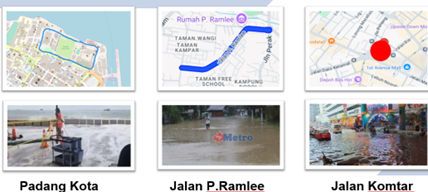The Concept of Workable Rainwater Harvesting Drainage System in Reducing Flash Flood Risk in Historical City
Keywords:
Rainwater Harvesting, Drainage System, Risk of Flash Flood, Historical CityAbstract
This study investigates how rainwater harvesting drainage systems can help mitigate flash flood risks in historic urban areas facing increasing threats from rapid development and climate change. Historic cities often have extensive impermeable surfaces, such as roads and buildings, preventing water from soaking into the ground. This leads to greater surface runoff during heavy rainfall, heightening the risk of flash floods. The research evaluates the effectiveness of existing rainwater harvesting drainage systems by combining quantitative data analysis and qualitative case studies. Field data are analysed using the Statistical Package for the Social Sciences (SPSS) to ensure robust results. Key features of successful systems include their capacity to capture, store, and redirect excess rainwater, thus reducing surface runoff volume and speed. Early findings show that rainwater harvesting drainage systems effectively reduce flash flood risk by promoting water infiltration and conserving rainwater for reuse. These benefits align with sustainable urban development goals. Additionally, enhancing drainage infrastructure can protect public buildings, homes, and critical services from flood damage, offering economic and social advantages. The study concludes by recommending improvements in drainage system design, legal enforcement, and urban planning practices. It emphasises the importance of context-appropriate solutions and regulatory compliance to building flood-resilient historic cities. Ultimately, these insights are intended to guide urban planners, policymakers, and developers in making informed decisions for safeguarding heritage cities from urban flooding.
References
[1] Y. Li, Urbanization and Global Environmental Change (UGEC) in Hong Kong: Preliminary Survey and Implication for Mainland China, 2010.
[2] State Planning Policy 4/10 Healthy Waters, 2010.
[3] A. Tavukcuoglu, A. Duzgunes, S. Demirci, and E.N. Caner-Saltık, The Assessment of a Roof Drainage System for an Historical Building, Building and Environment 42 (2007) 2699–2709. https://doi.org/10.1016/j.buildenv.2006.07.012.
[4] A. Zaiter, N. Sabtu, and D.F. Almaliki, Equations and Methodologies of Inlet Drainage System Discharge Coefficients: A Review, Open Engineering 14 (2024). https://doi.org/10.1515/eng-2022-0598.
[5] O. M. Abdeldayem, O. Eldaghar, M. K. Mostafa, M. M. Habashy, A.A. Hassan, H. Mahmoud, K. M. Morsy, A. Abdelrady, and R.W. Peters, Mitigation Plan and Water Harvesting of Flashflood in Arid Rural Communities Using Modelling Approach: A Case Study in Afouna Village, Egypt, Water 12 (2020) 2565. https://doi.org/10.3390/w12092565.
[6] Y. Qin, Urban Flooding Mitigation Techniques: A Systematic Review and Future Studies, Water 12 (2020) 3579. https://doi.org/10.3390/w12123579.
[7] R.M. Anvigh, J.F. Silva, and J. Macedo, Designing Sustainable Drainage Systems as a Tool to Deal with Heavy Rainfall—Case Study of Urmia City, Iran, Sustainability 16 (2024) 7349. https://doi.org/10.3390/su16177349.
[8] S.H. Kwon, and D. Jung, Multiperiod Optimization Framework for Urban Drainage System Planning: A Scenario-Based Approach, Journal of Water Resources Planning and Management 150 (2024). https://doi.org/10.1061/JWRMD5.WRENG-6119.
[9] C. Eves, The Impact of Flooding on Residential Property Buyer Behaviour: An England and Australian Comparison of Flood Affected Property, Structural Survey 22 (2004) 84–94. https://doi.org/10.1108/02630800410538613.
[10] T.S. Bibi, D. Reddythta, and A.S. Kebebew, Assessment of the Drainage Systems Performance in Response to Future Scenarios and Flood Mitigation Measures Using Stormwater Management Model, City and Environment Interactions 19 (2023) 100111. https://doi.org/10.1016/j.cacint.2023.100111.
[11] Government of Malaysia, Uniform Building By-Laws 1984 (PU(A) 413/1984), 1985.
[12] M. The Commissioner of Law Revision, Street, Drainage and Building Act 1974 (Act 133), 1974.
[13] Tembok Padang Kota Lama Mampu Tahan Air Pasang Hingga 2.5 Meter, Harian Metro (2024). https://www.hmetro.com.my/mutakhir/2024/09/1135251/tembok-padang-kota-lama-mampu-tahan-air-pasang-hingga-25-meter (accessed July 25, 2025).
[14] Pulau Pinang Dilanda Banjir Kilat Lagi, MStar (2018). https://www.mstar.com.my/lokal/semasa/2018/09/07/banjir-kilat (accessed July 25, 2025).
[15] Pulau Pinang Dilanda Banjir Kilat, Astro Awani (2023). https://www.astroawani.com/berita-malaysia/pulau-pinang-dilanda-banjir-kilat-435781 (accessed July 25, 2025).

Downloads
Published
Issue
Section
License
Copyright (c) 2025 Progress in Energy and Environment

This work is licensed under a Creative Commons Attribution-NonCommercial 4.0 International License.











